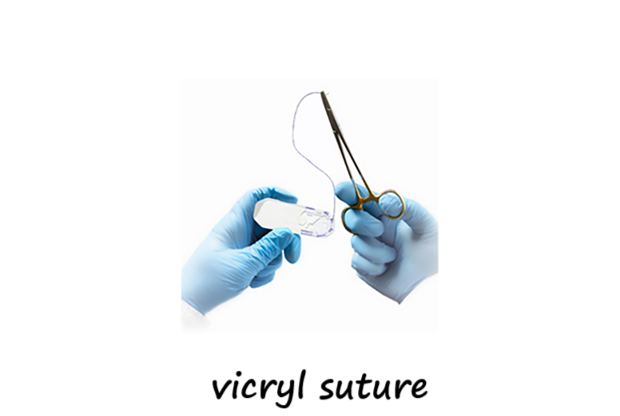When it comes to surgical procedures, the choice of suture material plays a critical role in ensuring optimal wound healing and patient outcomes. Among the many options available, Vicryl sutures have become a popular choice for surgeons worldwide. But what exactly are Vicryl sutures, and why are they so widely used? In this blog post, we’ll dive into everything you need to know about Vicryl sutures, their benefits, applications, and more.
What Are Vicryl Sutures?
Vicryl sutures are a type of synthetic, absorbable suture made from a copolymer of glycolide and lactide. Developed by Ethicon (a subsidiary of Johnson & Johnson), Vicryl sutures are designed to provide strong wound support during the critical healing phase and then gradually break down in the body over time. This eliminates the need for suture removal, making them a convenient option for both surgeons and patients.
Key Features of Vicryl Sutures
- Absorbable: Vicryl sutures are absorbed by the body through hydrolysis, a process where water breaks down the suture material. This typically occurs within 56 to 70 days, depending on the specific type of Vicryl suture used.
- Strength: Vicryl sutures retain their strength for approximately 2 to 3 weeks, which is often the most critical period for wound healing.
- Braided Structure: Vicryl sutures are braided, which provides excellent handling and knot security. This makes them easier for surgeons to work with compared to monofilament sutures.
- Versatility: Vicryl sutures are available in a variety of sizes and can be used for a wide range of surgical applications, including soft tissue approximation and ligation.
- Coated Options: Coated Vicryl sutures (Vicryl Plus) are treated with an antimicrobial agent to reduce the risk of surgical site infections.
Applications of Vicryl Sutures
Vicryl sutures are used in a variety of surgical procedures, including:
- General Surgery: For closing incisions in the abdomen, skin, and other soft tissues.
- Gynecological Surgery: Commonly used in procedures like hysterectomies and cesarean sections.
- Orthopedic Surgery: For repairing soft tissues around bones and joints.
- Ophthalmic Surgery: In certain eye procedures where absorbable sutures are required.
- Pediatric Surgery: Due to their absorbable nature, Vicryl sutures are often preferred for children to avoid the need for suture removal.
Advantages of Vicryl Sutures
- No Need for Removal: Since Vicryl sutures are absorbable, patients don’t need to return for suture removal, reducing discomfort and inconvenience.
- Reduced Risk of Infection: Coated Vicryl sutures (Vicryl Plus) are treated with triclosan, an antimicrobial agent that helps minimize the risk of surgical site infections.
- Excellent Handling: The braided structure of Vicryl sutures makes them easy to handle and tie, providing secure wound closure.
- Biocompatibility: Vicryl sutures are well-tolerated by the body, with minimal tissue reaction.
Potential Limitations
While Vicryl sutures offer numerous benefits, they may not be suitable for all situations. For example:
- They are not recommended for use in cardiovascular or neurological surgeries due to their absorption rate and tissue reactivity.
- In some cases, the braided structure may increase the risk of infection compared to monofilament sutures, although this is mitigated with coated Vicryl sutures.
Vicryl vs. Other Sutures
- Vicryl vs. Monocryl: Monocryl is another absorbable suture but is monofilament, making it smoother and less likely to harbor bacteria. However, Vicryl provides better knot security and handling.
- Vicryl vs. PDS: Polydioxanone (PDS) sutures are also absorbable but have a longer absorption time, making them suitable for tissues that require extended support.
- Vicryl vs. Non-Absorbable Sutures: Non-absorbable sutures like nylon or polypropylene are used when long-term wound support is needed, but they require removal and may cause more tissue reaction.
Tips for Using Vicryl Sutures
- Choose the Right Size: Select the appropriate suture size based on the tissue type and surgical site.
- Handle with Care: Avoid excessive tension when tying knots to prevent suture breakage.
- Consider Coated Options: For high-risk procedures, opt for Vicryl Plus to reduce infection risk.
- Monitor Healing: While Vicryl sutures are absorbable, it’s important to monitor the wound for signs of infection or delayed healing.
Conclusion
Vicryl sutures have revolutionized the field of surgery with their unique combination of strength, absorbability, and ease of use. Whether you’re a surgeon looking for reliable wound closure or a patient curious about your surgical options, Vicryl sutures offer a trusted solution for a wide range of medical procedures. As with any medical product, it’s essential to consult with your healthcare provider to determine the best suture material for your specific needs.
Have you or someone you know had experience with Vicryl sutures? Share your thoughts in the comments below! If you found this post helpful, don’t forget to share it with others who might benefit from this information.
Disclaimer: This blog post is for informational purposes only and should not be considered medical advice. Always consult with a qualified healthcare professional for medical guidance.



Leave a Reply